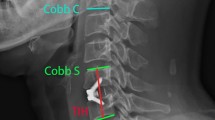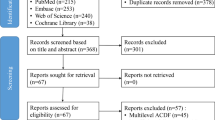Abstract
Purpose
The use of standalone cages (SAC) and anchored cages (AC) in anterior cervical discectomy and fusion surgery (ACDF) has shown advantage of reduced operative time and lower incidence of dysphagia. However, there is limited literature available comparing the clinical and radiological outcomes of SAC and AC.
Methods
We conducted a prospective study for patients undergoing ACDF for cervical radiculopathy or myelopathy. Patient were classified based on the cage used into SAC group and the AC group. Clinical outcomes were assessed using the modified Japanese Orthopedic Association (mJOA) for myelopathy and Neck Disability Index (NDI) and Visual Analogue Scale (VAS) for radiculopathy. Dysphagia was graded as per Bazaz score. Radiologically, global cervical lordosis, segmental lordosis, cage subsidence, and migration were assessed.
Results
We analyzed 31 patients in each group with a minimum two year follow-up. The mean VAS improved from 7.9 to 4.56, mean NDI score improved from 27.6 to 19.8, and mean mJOA improved from 10.8 to 11.7 which were statistically significant (p < 0.05); however, no significant difference was noted between the SAC and AC groups. Mean global lordosis improved from 14.4 to 20.3° and mean segmental lordosis improved from 6 to 10.1° at six months and plateaued to 6.9° at final follow up without any significant difference between the groups. The subsidence was statistically more in 12.9% (4/31) in SAC than 6.4% (2/31) in AC.
Conclusion
AC showed of lower rates of subsidence while both SAC and AC had comparable clinical outcomes and radiological alignment outcomes.


Similar content being viewed by others
Data availability
Data is not a part of a public repository.
References
Chong E, Pelletier MH, Mobbs RJ, Walsh WR (2015) The design evolution of interbody cages in anterior cervical discectomy and fusion: a systematic review. BMC Musculoskelet Disord 16:1–11
Korinth MC (2008) Treatment of cervical degenerative disc disease–current status and trends. Cen Eur Neurosurg 69:113–124
Iwasaki K, Ikedo T, Hashikata H, Toda H (2014) Autologous clavicle bone graft for anterior cervical discectomy and fusion with titanium interbody cage. J Neurosurg Spine 21:761–768
Song KJ, Taghavi CE, Lee KB, Song JH, Eun JP (2009) The efficacy of plate construct augmentation versus cage alone in anterior cervical fusion. Spine 34:2886–2892
Anderson DG, Albert TJ (2002) Bone grafting, implants, and plating options for anterior cervical fusions. Orthopedic Clinics 33:317–328
He S, Zhou Z, Lv N, Shao X, Zhou X, Wang Y et al (2021) Comparison of clinical outcomes following anterior cervical discectomy and fusion with zero-profile anchored spacer-ROI-C-fixation and combined intervertebral cage and anterior cervical discectomy and fusion: a retrospective study from a single center. Med Sci Monit: Int Med J Exp Clin Res 27:e931050–e931051
Vaishnav AS, Saville P, McAnany S, Haws B, Khechen B, Singh K et al (2019) Predictive factors of postoperative dysphagia in single-level anterior cervical discectomy and fusion. Spine 44:E400–E407
Joo YH, Lee JW, Kwon KY, Rhee JJ, Lee HK (2010) Comparison of fusion with cage alone and plate instrumentation in two-level cervical degenerative disease. J Korean Neurosurg Soc 48:342
Nemoto O, Kitada A, Naitou S, Tachibana A, Ito Y, Fujikawa A (2015) Stand-alone anchored cage versus cage with plating for single-level anterior cervical discectomy and fusion: a prospective, randomized, controlled study with a 2-year follow-up. Eur J Orthop Surg Traumatol 25:127–134
Fujibayashi S, Neo M, Nakamura T (2008) Stand-alone interbody cage versus anterior cervical plate for treatment of cervical disc herniation: sequential changes in cage subsidence. J Clin Neurosci 15:1017–1022
Oh JK, Kim TY, Lee HS, You NK, Choi GH, Yi S et al (2013) Stand-alone cervical cages versus anterior cervical plate in 2-level cervical anterior interbody fusion patients: clinical outcomes and radiologic changes. Clin Spine Surg 26:415–420
Bartels RH, Donk RD, Feuth T (2006) Subsidence of stand-alone cervical carbon fiber cages. Neurosurgery 58:502–508
Kast E, Derakhshani S, Bothmann M, Oberle J (2009) Subsidence after anterior cervical inter-body fusion. A randomized prospective clinical trial. Neurosurg Rev 32:207–214
Wang Z, Jiang W, Li X, Wang H, Shi J, Chen J et al (2015) The application of zero-profile anchored spacer in anterior cervical discectomy and fusion. Eur Spine J 24:148–154
Hofstetter CP, Kesavabhotla K, Boockvar JA (2015) Zero-profile anchored spacer reduces rate of dysphagia compared with ACDF with anterior plating. J Spinal Disord Tech 28:E284–E290
Dufour T, Huppert J, Louis C, Beaurain J, Stecken J, Aubourg L, Vila T (2010) Radiological analysis of 37 segments in cervical spine implanted with a peek stand-alone device, with at least one year follow-up. Br J Neurosurg 24:633–640
Bazaz R, Lee MJ, Yoo JU (2002) Incidence of dysphagia after anterior cervical spine surgery: a prospective study. Spine 27:2453–2458
Li J, Lei T, Shen Y (2015) The impact of Modic-2 changes on the clinical outcomes of single-level anterior cervical discectomy and fusion. Eur Spine J 24:2936–2940
Son DK, Son DW, Kim HS, Sung SK, Lee SW, Song GS (2014) Comparative study of clinical and radiological outcomes of a zero-profile device concerning reduced postoperative dysphagia after single level anterior cervical discectomy and fusion. J Korean Neurosurg Soc 56:103
Oh K, Lee CK, You NK, Kim SH, Cho KH (2013) Radiologic changes of anterior cervical discectomy and fusion using allograft and plate augmentation: comparison of using fixed and variable type screw. Korean J Spine 10:160
Pfirrmann CW, Metzdorf A, Zanetti M, Hodler J, Boos N (2001) Magnetic resonance classification of lumbar intervertebral disc degeneration. Spine 26:1873–1878
Gercek E, Arlet V, Delisle J, Marchesi D (2003) Subsidence of stand-alone cervical cages in anterior interbody fusion: warning. Eur Spine J 12:513–516
Han SY, Kim HW, Lee CY, Kim HR, Park DH (2016) Stand-alone cages for anterior cervical fusion: are there no problems? Korean J Spine 13:13
Cho HJ, Hur JW, Lee JB, Han JS, Cho TH, Park JY (2015) Cervical Stand-alone polyetheretherketone cage versus zero-profile anchored spacer in single-level anterior cervical discectomy and fusion: minimum 2-year assessment of radiographic and clinical outcome. J Korean Neurosurg Soc 58:119
Wang T, Ma L, Yang DL, Wang H, Bai ZL, Zhang LJ, Ding WY (2017) Factors predicting dysphagia after anterior cervical surgery: a multicenter retrospective study for 2 years of follow-up. Medicine 96:34
Tervonen H, Niemelä M, Lauri ER, Bäck L, Juvas A, Räsänen P et al (2007) Dysphonia and dysphagia after anterior cervical decompression. J Neurosurg Spine 7:124–130
Li Z, Zhao Y, Tang J, Ren D, Guo J, Wang H, Li L, Hou S (2017) A comparison of a new zero-profile, stand-alone Fidji cervical cage and anterior cervical plate for single and multilevel ACDF: a minimum 2-year follow-up study. Eur Spine J 26:1129–1139. https://doi.org/10.1007/s00586-016-4739-2
Lee YS, Kim YB, Park SW (2014) Risk factors for postoperative subsidence of single-level anterior cervical discectomy and fusion: the significance of the preoperative cervical alignment. Spine 39:1280–1287
Kim S, Chun HJ, Yi HJ, Bak KH, Kim DW, Lee YK (2012) Long-term follow-up radiologic and clinical evaluation of cylindrical cage for anterior interbody fusion in degenerative cervical disc disease. J Korean Neurosurg Soc 52:107
Hida K, Iwasaki Y, Yano S, Akino M, Seki T (2008) Long-term follow-up results in patients with cervical disk disease treated by cervical anterior fusion using titanium cage implants. Neurol Med Chir (Tokyo) 48(10):440–446. https://doi.org/10.2176/nmc.48.440
Schmieder K, Wolzik-Grossmann M, Pechlivanis I, Engelhardt M, Scholz M, Harders A (2006) Subsidence of the wing titanium cage after anterior cervical interbody fusion: 2-year follow-up study. J Neurosurg Spine 4:447–453
Author information
Authors and Affiliations
Contributions
All authors contributed to the study conception and design. Material preparation, data collection, and analysis were performed by Dr Siddharth Aiyer, Dr Shailesh Hadgaonkar, and Dr Ajay Kothari. The first draft of the manuscript was written by Dr Niharika Virkar and Dr Pramod Bhilare and critical revision was done by Dr Siddharth Aiyer. Project administration was carried out by Dr Parag Sancheti. All authors commented on previous versions of the manuscript. All authors read and approved the final manuscript.
Corresponding author
Ethics declarations
Ethics approval
This study was performed in line with the principles of the Declaration of Helsinki. Approval was granted by the Sancheti Institute for Orthopaedics and Rehabilitation Institute Ethics Committee (Date: 2/11/2019 /No:IEC-SIOR/Agenda 058).
Consent to participate
Informed consent was obtained from all individual participants included in the study.
Consent for publications
The authors affirm that human research participants provided informed consent for publication of the images in Figs. 1 and 2.
Conflict of interests
The authors declare no competing interests.
Additional information
Publisher's note
Springer Nature remains neutral with regard to jurisdictional claims in published maps and institutional affiliations.
Rights and permissions
About this article
Cite this article
Virkar, N., Bhilare, P., Hadgaonkar, S. et al. Standalone cage versus anchored cage for anterior cervical discectomy and fusion: a comparative analysis of clinical and radiological outcomes. International Orthopaedics (SICOT) 46, 2339–2345 (2022). https://doi.org/10.1007/s00264-022-05493-z
Received:
Accepted:
Published:
Issue Date:
DOI: https://doi.org/10.1007/s00264-022-05493-z




